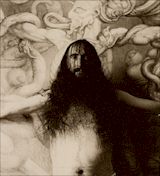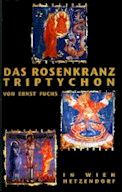Ernst Fuchs and the Vienna School of
Fantastic Realism by Alan Senior
The Vienna School of Fantastic Realism formed in 1946 and included Ernst Fuchs, Rudolph Hausner, Wolfgang Hutter and Fritz Janschka. Arik Brauer and AntonLemden joined later. The group saw itself as surrealist although they were already moving away from the surrealist painting of the 1930s towards a more visionary approach. Technically their work had the clarity and detail of early Flemish Painting.
They were quite influential on the
continent, but little known or appreciated in Britain. In 1957 Hausner
fell out with surrealist His paintings from the late 50s to the present day have extraordinary visionary power Babylonian Cherubs, visions of Christ and other mythological subjects explore the roots of middle eastern religious experience. The power of colour form and content set his work apart from modernism.
In 1970, he began to work on monumental sculptures. Later in 1973, he acquired the Otto Wagner Villa in Vienna, which he subsequently renovated completely and which is now the Ernst Fuchs Museum and contains a complete range of his work to date. He then undertook stage designs for operas, especially Wagner. In the 1980s, he had a number of international exhibitions including a retrospective in Venice. In 1993 he had a major retrospective in Russia — one of the first major western artists to do so. |


 orthodoxy after completing his first Adam picture and
split from Fuchs and the others to pursue his own vision. Fuchs had
already moved away from surrealism into visionary mannerism. He painted
a number of paintings with religious subjects culminating in his
triptych
orthodoxy after completing his first Adam picture and
split from Fuchs and the others to pursue his own vision. Fuchs had
already moved away from surrealism into visionary mannerism. He painted
a number of paintings with religious subjects culminating in his
triptych 